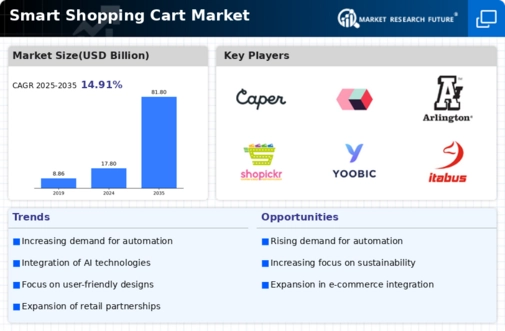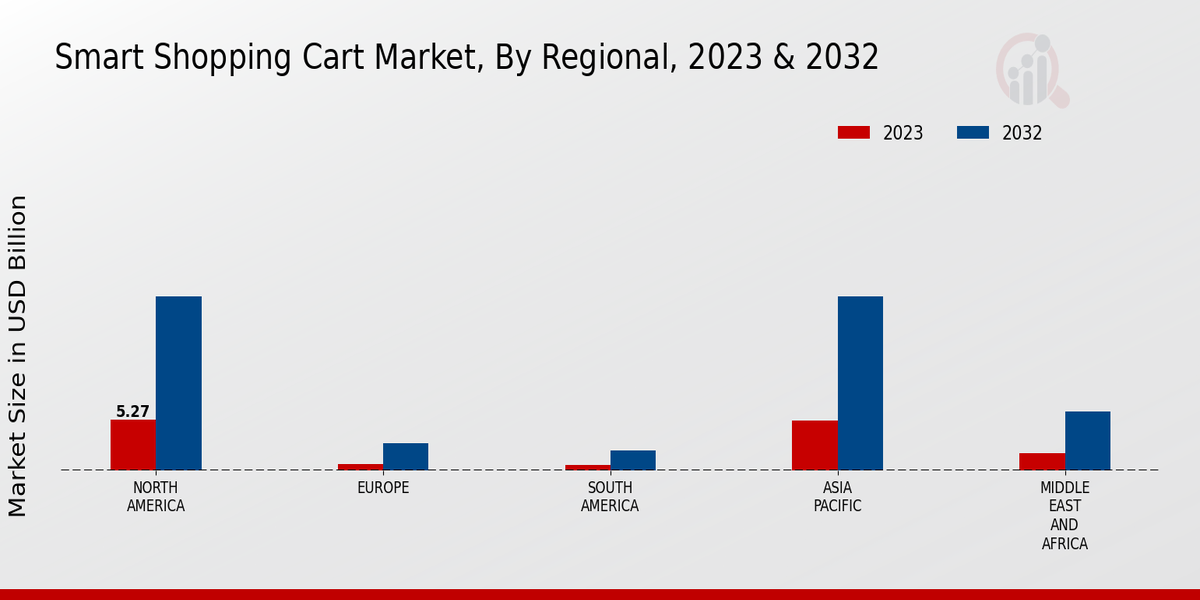Focus on Sustainability
Sustainability is becoming increasingly important in the Global Smart Shopping Cart Market Industry, as consumers and retailers alike prioritize eco-friendly practices. Smart shopping carts are being designed with sustainable materials and energy-efficient technologies, appealing to environmentally conscious shoppers. Retailers are adopting these carts not only to meet consumer expectations but also to enhance their brand image. This focus on sustainability is likely to drive market growth, as consumers are more inclined to support businesses that demonstrate a commitment to environmental responsibility. The evolving landscape suggests that sustainability will play a crucial role in shaping the future of the Global Smart Shopping Cart Market.
Market Growth Projections
The Global Smart Shopping Cart Market Industry is poised for substantial growth, with projections indicating a market size of 17.8 USD Billion in 2024 and a remarkable increase to 81.8 USD Billion by 2035. This growth trajectory is supported by a compound annual growth rate (CAGR) of 14.89% from 2025 to 2035. Such figures reflect the increasing adoption of smart shopping carts across various retail sectors, driven by technological advancements, consumer demand for convenience, and the integration of e-commerce solutions. The market's expansion is indicative of a broader trend towards innovation in retail, positioning smart shopping carts as a key component of future shopping experiences.
Technological Advancements
The Global Smart Shopping Cart Market Industry is experiencing a surge in technological advancements that enhance the shopping experience. Innovations such as RFID technology, computer vision, and artificial intelligence are being integrated into smart shopping carts, allowing for real-time inventory tracking and automated checkout processes. These technologies not only streamline operations but also improve customer satisfaction by reducing wait times. As a result, the market is projected to reach 17.8 USD Billion in 2024, reflecting a growing consumer preference for efficient shopping solutions. Retailers are increasingly adopting these technologies to stay competitive, indicating a robust future for the Global Smart Shopping Cart Market.
Consumer Demand for Convenience
In the Global Smart Shopping Cart Market Industry, there is a notable increase in consumer demand for convenience and efficiency in shopping. Modern consumers seek seamless experiences that minimize time spent in stores. Smart shopping carts, equipped with features such as navigation assistance and personalized promotions, cater to this demand. This shift in consumer behavior is driving retailers to invest in smart cart technologies, thereby expanding the market. The anticipated growth trajectory suggests that by 2035, the market could reach 81.8 USD Billion, highlighting the importance of convenience in shaping retail strategies within the Global Smart Shopping Cart Market.
Enhanced Data Analytics Capabilities
The Global Smart Shopping Cart Market Industry is witnessing a rise in enhanced data analytics capabilities, which provide retailers with valuable insights into consumer behavior. Smart shopping carts equipped with data collection tools can analyze shopping patterns, preferences, and trends, enabling retailers to tailor their offerings accordingly. This data-driven approach not only improves inventory management but also enhances marketing strategies, leading to increased sales and customer satisfaction. As retailers recognize the value of data analytics, the adoption of smart shopping carts is expected to grow, contributing to the overall expansion of the market.
Integration with E-commerce Platforms
The integration of smart shopping carts with e-commerce platforms is a pivotal driver in the Global Smart Shopping Cart Market Industry. As online shopping continues to gain traction, retailers are leveraging smart carts to bridge the gap between physical and digital shopping experiences. This integration allows for features such as online order pickups and personalized recommendations based on online shopping history. Such capabilities enhance customer engagement and loyalty, making smart shopping carts an essential tool for retailers. The market's growth is further supported by a projected CAGR of 14.89% from 2025 to 2035, indicating a strong alignment between e-commerce and in-store shopping innovations.














